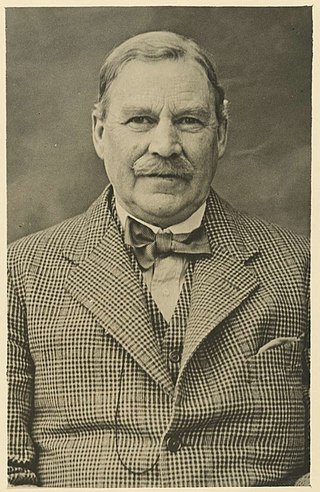
Andrew Barton "Banjo" Paterson, was an Australian bush poet, journalist and author. He wrote many ballads and poems about Australian life, focusing particularly on the rural and outback areas, including the district around Binalong, New South Wales, where he spent much of his childhood. Paterson's more notable poems include "Clancy of the Overflow" (1889), "The Man from Snowy River" (1890) and "Waltzing Matilda" (1895), regarded widely as Australia's unofficial national anthem.

"The Man from Snowy River" is a poem by Australian bush poet Banjo Paterson. It was first published in The Bulletin, an Australian news magazine, on 26 April 1890, and was published by Angus & Robertson in October 1895, with other poems by Paterson, in The Man from Snowy River and Other Verses.

Will H. Ogilvie was a Scottish-Australian narrative poet and horseman, jackaroo, and drover, and described as a quiet-spoken handsome Scot of medium height, with a fair moustache and red complexion. He was also known as Will Ogilvie, by the pen names including 'Glenrowan' and the lesser 'Swingle-Bar', and by his initials, WHO.

Barcroft Henry Thomas Boake was an Australian poet.

Adaminaby is a small town near the Snowy Mountains north-west of Cooma, New South Wales, Australia, in the Snowy Monaro Regional Council. The historic town, of 301 people at the 2016 census, is a trout fishing centre and winter sports destination situated at 1,017 metres (3,337 ft) above sea level. Economic life is built around tourism and agriculture–the town serves as a service point for Selwyn Snowfields and the Northern Skifields. It is also a popular destination for horse riders, bushwalkers, fly-fishermen and water sports enthusiasts as well as a base for viewing aspects of the Snowy Mountains Scheme.
Nationality words link to articles with information on the nation's poetry or literature.

Charles Harpur was an Australian poet and playwright. He is regarded as "Australia's most important nineteenth-century poet."
The Never Never is the name of a vast, remote area of the Australian Outback, as described in Barcroft Boake's poem "Where the Dead Men Lie":

The Sydney Mail was an Australian magazine published weekly in Sydney. It was the weekly edition of The Sydney Morning Herald newspaper and ran from 1860 to 1938.

Clement Semmler OBE, AM, often referred to as Clem Semmler, was an Australian author, literary critic, broadcaster and radio and television executive.
This article presents a list of the historical events and publications of Australian literature during 1897.
This article presents a list of the historical events and publications of Australian literature during 1892.
This article presents a list of the historical events and publications of Australian literature during 1891.
This article presents a list of the historical events and publications of Australian literature during 1890.
The Old Whim Horse is a poem by Australian writer and poet Edward Dyson. It was first published in The Bulletin magazine on 30 July 1892, and later in the poet's collection Rhymes from the Mines and Other Lines (1896).
"Where the Dead Men Lie" is a poem by Australian poet Barcroft Boake. It was first published in The Bulletin magazine on 19 December 1891, and later in the poet's poetry collection Where the Dead Men Lie, and Other Poems (1897).

Barcroft Capel Boake was an Australian photographer. He is most famous for his mosaic of the New South Wales Contingent produced in 1885 which represents the soldiers returned from the war in Sudan.
Rio Grande's Last Race is a racing poem by Australian writer and poet Andrew Barton "Banjo" Paterson. It was first published in the London Sketch magazine on 16 December 1896. It was later published as the title poem for Paterson's second poetry collection, Rio Grande's Last Race and Other Verses, in 1902.
Where the Dead Men Lie, and Other Poems (1897) is the first and only collection of poems by Australian poet Barcroft Boake. Edited by A. G. Stephens, it was released in hardback by Angus and Robertson in 1897, five years after the poet's death. It contains an introduction by the editor, an introductory poem by Will H. Ogilvie, and features the poet's major works "Jack's Last Muster", "Jim's Whip" and "Where the Dead Men Lie".
This article presents a list of the historical events and publications of Australian literature during 1866.








